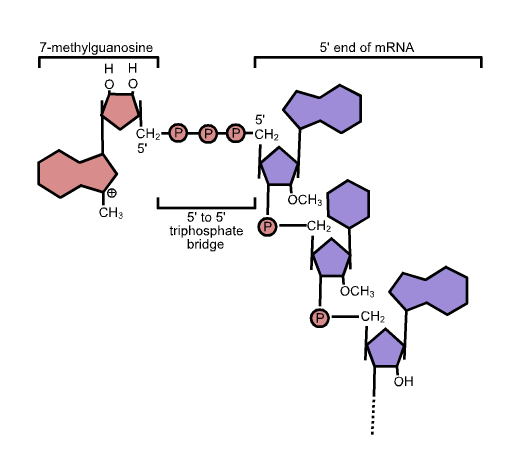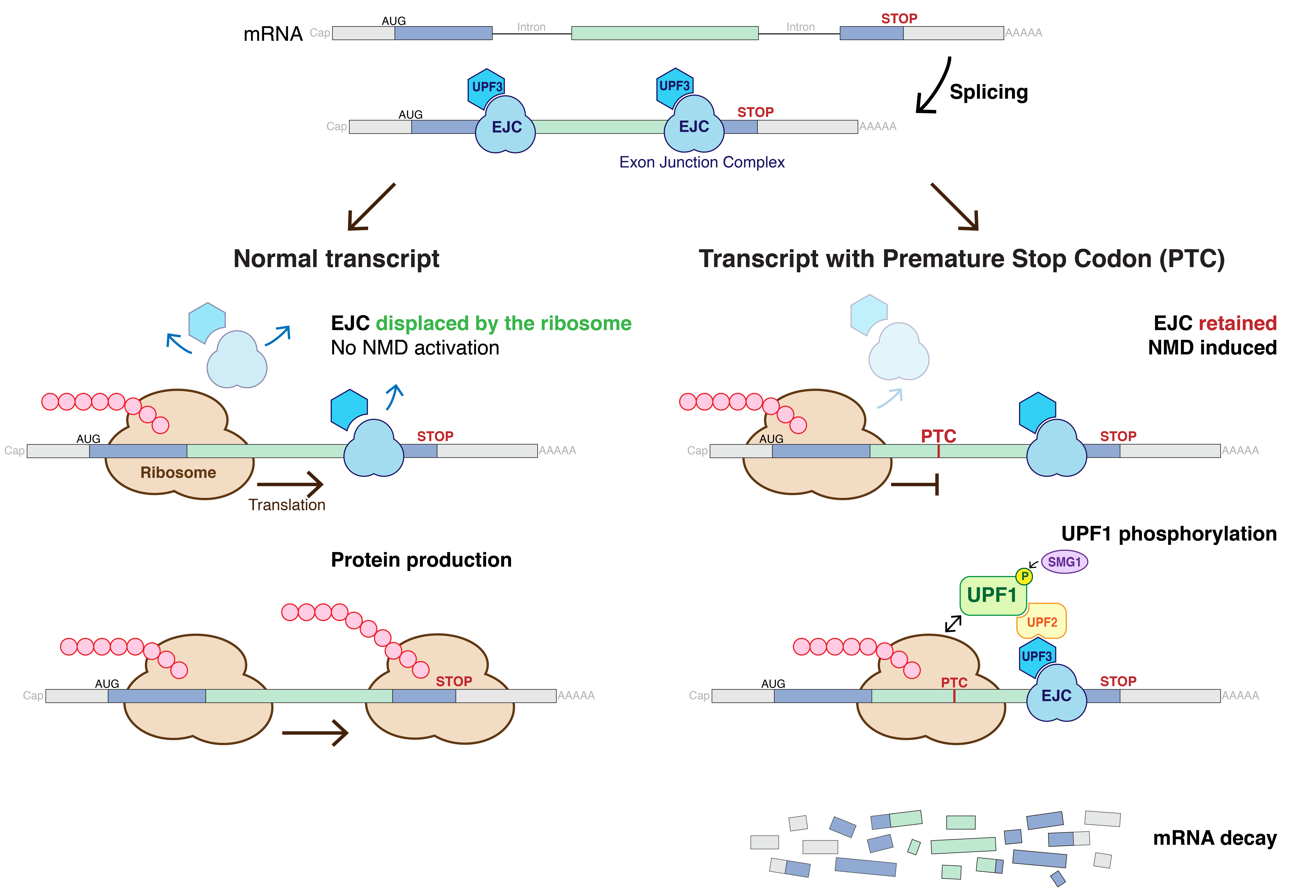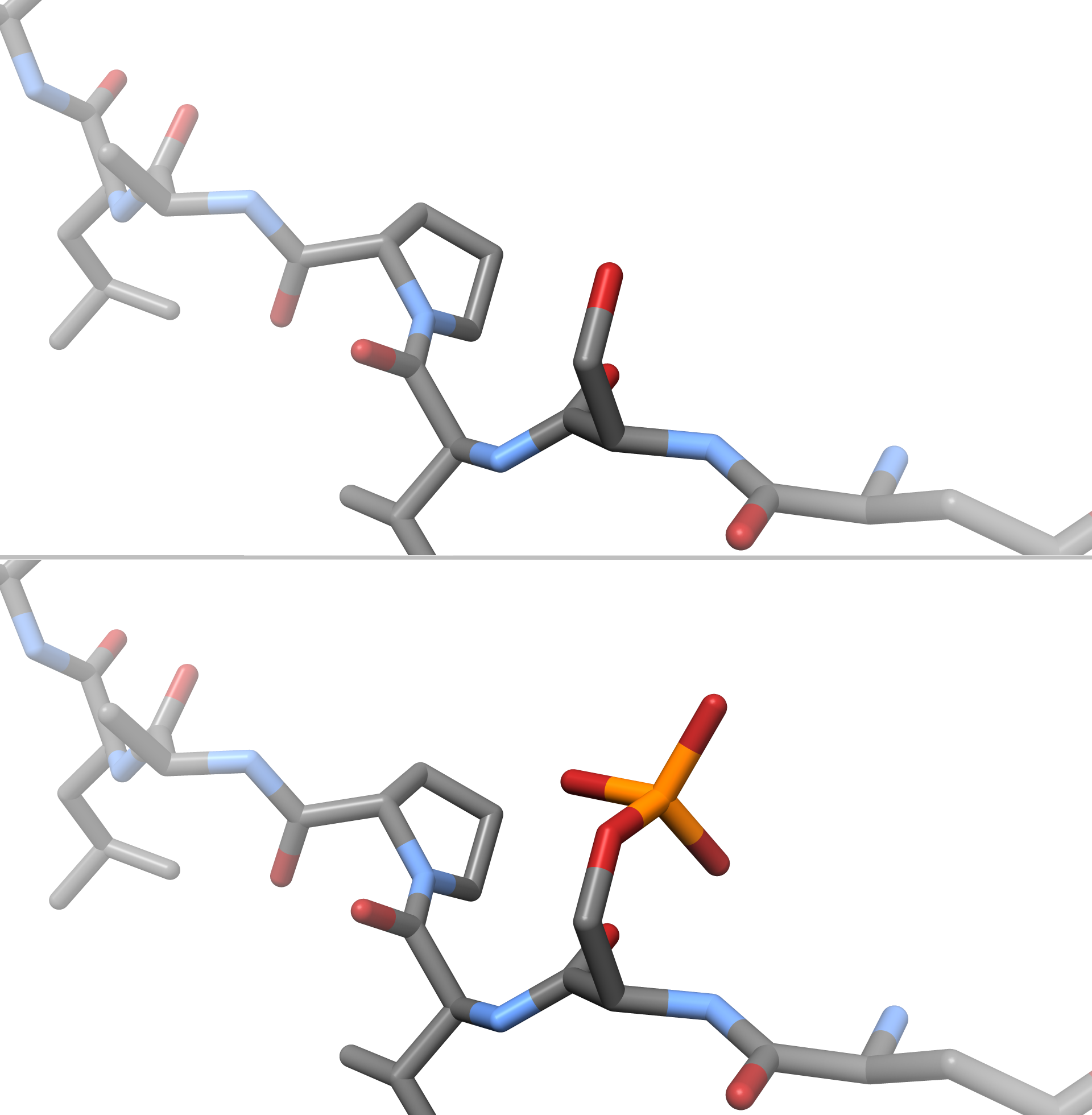|
Cap Binding Complex
The 5' cap of eukaryotic messenger RNA is bound at all times by various cap-binding complexes (CBCs). Nuclear cap-binding complex In the nucleus, freshly transcribed mRNA molecules are bound on the 5' cap by the nuclear cap-binding complex of Cbc1/Cbc2 in yeast or CBP20/CBP80 in metazoans. These aid in the export of the mRNA and protect it from decapping. They also serve as a marker for the so-called pioneer round of translation when the message is examined by nonsense mediated decay. Cytoplasmic cap-binding complex After the first round of translation ("pioneer round"), CBC20/80 is replaced by the translation initiation factor eIF4E. The eIF4F complex (eIF4E, eIF4G and eIF4A) then regulates translation in response to the state of the cell via its phosphorylation state and again protects the message from decapping. Decapping complex When translationally repressed or marked for decay by various mechanisms the 5' cap is bound by the mRNA decapping enzyme DCP2. A host of ... [...More Info...] [...Related Items...] OR: [Wikipedia] [Google] [Baidu] |
5' Cap
In molecular biology, the five-prime cap (5′ cap) is a specially altered nucleotide on the 5′ end of some primary transcripts such as precursor messenger RNA. This process, known as mRNA capping, is highly regulated and vital in the creation of stable and mature messenger RNA able to undergo translation during protein synthesis. Mitochondrial mRNA and chloroplastic mRNA are not capped. Structure In eukaryotes, the 5′ cap (cap-0), found on the 5′ end of an mRNA molecule, consists of a guanine nucleotide connected to mRNA via an unusual 5′ to 5′ triphosphate linkage. This guanosine is methylated on the 7 position directly after capping ''in vivo'' by a methyltransferase. It is referred to as a 7-methylguanylate cap, abbreviated m7G. In multicellular eukaryotes and some viruses, further modifications exist, including the methylation of the 2′ hydroxy-groups of the first 2 ribose sugars of the 5′ end of the mRNA. cap-1 has a methylated 2′-hydroxy group ... [...More Info...] [...Related Items...] OR: [Wikipedia] [Google] [Baidu] |
Messenger RNA
In molecular biology, messenger ribonucleic acid (mRNA) is a single-stranded molecule of RNA that corresponds to the genetic sequence of a gene, and is read by a ribosome in the process of synthesizing a protein. mRNA is created during the process of transcription, where an enzyme (RNA polymerase) converts the gene into primary transcript mRNA (also known as pre-mRNA). This pre-mRNA usually still contains introns, regions that will not go on to code for the final amino acid sequence. These are removed in the process of RNA splicing, leaving only exons, regions that will encode the protein. This exon sequence constitutes mature mRNA. Mature mRNA is then read by the ribosome, and, utilising amino acids carried by transfer RNA (tRNA), the ribosome creates the protein. This process is known as translation. All of these processes form part of the central dogma of molecular biology, which describes the flow of genetic information in a biological system. As in DNA, genet ... [...More Info...] [...Related Items...] OR: [Wikipedia] [Google] [Baidu] |
Nuclear Cap-binding Protein Complex
Nuclear cap-binding protein complex is a RNA-binding protein which binds to the 5' cap of pre-mRNA. The cap and nuclear cap-binding protein have many functions in mRNA biogenesis including splicing, 3'-end formation by stabilizing the interaction of the 3'-end processing machinery, nuclear export and protection of the transcripts from nuclease degradation. When RNA is exported to the cytoplasm the nuclear cap-binding protein complex is replaced by cytoplasmic cap binding complex. The nuclear cap-binding complex is a functional heterodimer and composed of Cbc1/Cbc2 in yeast and CBC20/CBC80 in multicellular eukaryotes. Human nuclear cap-binding protein complex shows the large subunit, CBC80 consists of 757 amino acid residues. Its secondary structure contains approximately sixty percent of helical and one percent of beta sheet in the strand. The small subunit, CBC20 has 98 amino acid residues. Its secondary structure contains approximately twenty percent of helical and twenty-four p ... [...More Info...] [...Related Items...] OR: [Wikipedia] [Google] [Baidu] |
Messenger RNA Decapping
The process of messenger RNA decapping consists of hydrolysis of the 5' cap structure on the RNA exposing a 5' monophosphate. In eukaryotes, this 5' monophosphate is a substrate for the 5' exonuclease Xrn1 and the mRNA is quickly destroyed. There are many situations which may lead to the removal of the cap, some of which are discussed below. In prokaryotes, the initial mRNA transcript naturally possesses a 5'-triphosphate group after bacterial transcription; the enzyme RppH removes a pyrophosphate molecule from the 5' end, converting the 5'-triphosphate to a 5'-monophosphate, triggering mRNA degradation by ribonucleases. Translation and decay Inside cells, there is a balance between the processes of translation and mRNA decay. Messages which are being actively translated are bound by polysomes and the eukaryotic initiation factors eIF-4E and eIF-4G (in eukaryotes). This blocks access to the cap by the decapping enzyme DCP2 and protects the mRNA molecule. In nutrient-star ... [...More Info...] [...Related Items...] OR: [Wikipedia] [Google] [Baidu] |
Nonsense Mediated Decay
Nonsense-mediated mRNA decay (NMD) is a surveillance pathway that exists in all eukaryotes. Its main function is to reduce errors in gene expression by eliminating mRNA transcripts that contain premature stop codons. Translation of these aberrant mRNAs could, in some cases, lead to deleterious gain-of-function or dominant-negative activity of the resulting proteins. NMD was first described in human cells and in yeast almost simultaneously in 1979. This suggested broad phylogenetic conservation and an important biological role of this intriguing mechanism. NMD was discovered when it was realized that cells often contain unexpectedly low concentrations of mRNAs that are transcribed from alleles carrying nonsense mutations. Nonsense mutations code for a premature stop codon which causes the protein to be shortened. The truncated protein may or may not be functional, depending on the severity of what is not translated. In human genetics, NMD has the possibility to not only limit the ... [...More Info...] [...Related Items...] OR: [Wikipedia] [Google] [Baidu] |
Translation (genetics)
In molecular biology and genetics, translation is the process in which ribosomes in the cytoplasm or endoplasmic reticulum synthesize proteins after the process of transcription of DNA to RNA in the cell's nucleus. The entire process is called gene expression. In translation, messenger RNA (mRNA) is decoded in a ribosome, outside the nucleus, to produce a specific amino acid chain, or polypeptide. The polypeptide later folds into an active protein and performs its functions in the cell. The ribosome facilitates decoding by inducing the binding of complementary tRNA anticodon sequences to mRNA codons. The tRNAs carry specific amino acids that are chained together into a polypeptide as the mRNA passes through and is "read" by the ribosome. Translation proceeds in three phases: # Initiation: The ribosome assembles around the target mRNA. The first tRNA is attached at the start codon. # Elongation: The last tRNA validated by the small ribosomal subunit (''accommod ... [...More Info...] [...Related Items...] OR: [Wikipedia] [Google] [Baidu] |
EIF4E
Eukaryotic translation initiation factor 4E, also known as eIF4E, is a protein that in humans is encoded by the ''EIF4E'' gene. Structure and function Most eukaryotic cellular mRNAs are blocked at their 5'-ends with the 7-methyl- guanosine five-prime cap structure, m7GpppX (where X is any nucleotide). This structure is involved in several cellular processes including enhanced translational efficiency, splicing, mRNA stability, and RNA nuclear export. eIF4E is a eukaryotic translation initiation factor involved in directing ribosomes to the cap structure of mRNAs. It is a 24-kD polypeptide that exists as both a free form and as part of the eIF4F pre-initiation complex. Almost all cellular mRNA require eIF4E in order to be translated into protein. The eIF4E polypeptide is the rate-limiting component of the eukaryotic translation apparatus and is involved in the mRNA-ribosome binding step of eukaryotic protein synthesis. The other subunits of eIF4F are a 47-kD polypeptide, ... [...More Info...] [...Related Items...] OR: [Wikipedia] [Google] [Baidu] |
EIF4G
Eukaryotic translation initiation factor 4 G (eIF4G) is a protein involved in eukaryotic translation initiation and is a component of the eIF4F cap-binding complex. Orthologs of eIF4G have been studied in multiple species, including humans, yeast, and wheat. However, eIF4G is exclusively found in domain Eukarya, and not in domains Bacteria or Archaea, which do not have capped mRNA. As such, eIF4G structure and function may vary between species, although the human EIF4G1 has been the focus of extensive studies. (Other human paralogs are EIF4G2 and EIF4G3.) Across species, eIF4G strongly associates with eIF4E, the protein that directly binds the mRNA cap. Together with the RNA helicase protein eIF4A, these form the eIF4F complex. Within the cell eIF4G is found primarily in the cytoplasm, usually bound to eIF4E; however, it is also found in the nucleus, where its function is unknown. It may have a role in nonsense-mediated decay. History eIF4G stands for eukaryotic initia ... [...More Info...] [...Related Items...] OR: [Wikipedia] [Google] [Baidu] |
EIF4A
The eukaryotic initiation factor-4A (eIF4A) family consists of 3 closely related proteins EIF4A1, EIF4A2, and EIF4A3. These factors are required for the binding of mRNA to 40S ribosomal subunits. In addition these proteins are helicases that function to unwind double-stranded RNA. Background The mechanisms governing the basic subsistence of eukaryotic cells are immensely complex; it is therefore unsurprising that regulation occurs at a number of stages of protein synthesis – the regulation of translation has become a well-studied field. Human translational control is of increasing research interest as it has connotations in a range of diseases. Orthologs of many of the factors involved in human translation are shared by a range of eukaryotic organisms; some of which are used as model systems for the investigation of translation initiation and elongation, for example: sea urchin eggs upon fertilization, rodent brain and rabbit reticulocytes. Monod and Jacob were among t ... [...More Info...] [...Related Items...] OR: [Wikipedia] [Google] [Baidu] |
Phosphorylation
In chemistry, phosphorylation is the attachment of a phosphate group to a molecule or an ion. This process and its inverse, dephosphorylation, are common in biology and could be driven by natural selection. Text was copied from this source, which is available under a Creative Commons Attribution 4.0 International License. Protein phosphorylation often activates (or deactivates) many enzymes. Glucose Phosphorylation of sugars is often the first stage in their catabolism. Phosphorylation allows cells to accumulate sugars because the phosphate group prevents the molecules from diffusing back across their transporter. Phosphorylation of glucose is a key reaction in sugar metabolism. The chemical equation for the conversion of D-glucose to D-glucose-6-phosphate in the first step of glycolysis is given by :D-glucose + ATP → D-glucose-6-phosphate + ADP :ΔG° = −16.7 kJ/mol (° indicates measurement at standard condition) Hepatic cells are freely permeable to glucose, an ... [...More Info...] [...Related Items...] OR: [Wikipedia] [Google] [Baidu] |
DCP2
mRNA-decapping enzyme 2 is a protein that in humans is encoded by the ''DCP2'' gene In biology, the word gene (from , ; "... Wilhelm Johannsen coined the word gene to describe the Mendelian units of heredity..." meaning ''generation'' or ''birth'' or ''gender'') can have several different meanings. The Mendelian gene is a b .... DCP2 is a key component of an mRNA-decapping complex required for removal of the 5-prime cap from mRNA prior to its degradation from the 5-prime end (Fenger-Gron et al., 2005). upplied by OMIMref name="entrez" /> Interactions DCP2 has been shown to interact with DCP1A and UPF1. References Further reading * * * * * * * * * * * * * * {{gene-5-stub Nudix hydrolases ... [...More Info...] [...Related Items...] OR: [Wikipedia] [Google] [Baidu] |




